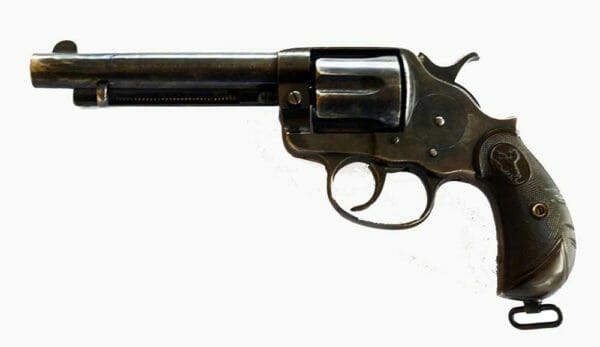
U.S.A. –-(Ammoland.com)- One of those rare revolvers came into my grasp, but little did I know that picking up a $75 junker would result in restoring a Colt M1878 Frontier Six-Shooter in 44 WCF.
It happened a few years ago while visiting my local Cabela’s. The manager of the Gun Department approached the author and said, “I may have something that’s right up your alley.”
Having heard Erick say those words to me in the past, I suspected it was going to create a dent in my wallet and I would have been better off leaving the wallet in an alley. Fortunately this time it would be a little bit more indirect.
He went into the back room and produced a Colt M1878 Frontier Six Shooter. The big double-action revolver chambered in 44 WCF (Winchester Center Fire aka.44-40) with a bird’s head grip was missing most of its finish and the lanyard ring, but otherwise looked complete.
Knowing the sky-rocketing prices of antique Colts, I examined it carefully before getting ready to turn it down.
The cylinder did not have positive lock up and hitting one of the chambers would cause it to spin completely like a roulette wheel in one of the downtown casinos. About 60% of the finish was remaining and there was some pitting on the frame. The hammer and trigger seemed to work fine and surprisingly, all the numbers matched. The single line of Colt’s address was clearly stamped on the top of the barrel, but the markings on the side of the barrel were faint.
Aside from the lockup, the revolver was in decent shape considering it was made in 1898, but what caught the author’s attention were 6 notches cut into the left grip panel. Could this make for a nice winter project? Did I have the skills with regard to restoring a Colt M1878 Frontier Six Shooter?
Asking how much the shop wanted for it, the author was preparing to say “Thanks, but no.” When the answer came back at $75 out the door, we figured even if it could not be restored, it could be parted out for a decent profit and I bought it on the spot.
History of the Colt M1878 Frontier Six-Shooter
Samuel Colt had tinkered with double-action revolvers when he founded his company in 1847, but found the design to be lacking and unreliable. Thirty years later, Colt’s Patent Fire Arms would turn out their first double-action revolver called the M1877 and better known as the Thunderer or Lightning model, depending upon the caliber (41 Colt and 38 Colt respectively).
This was a graceful small frame revolver best suited for concealment, but the trigger and lock work were considered to be fragile. It proved popular enough that Colt’s clientele clamored for a larger frame version and in 1878, William Mason, Colt’s factory manager and Charles Brinckerhoff Richards, Superintendent of Engineering developed a more robust design based on their first large framed effort, the Model 1873, better known as the Single Action Army (SAA) or “Peacemaker”.
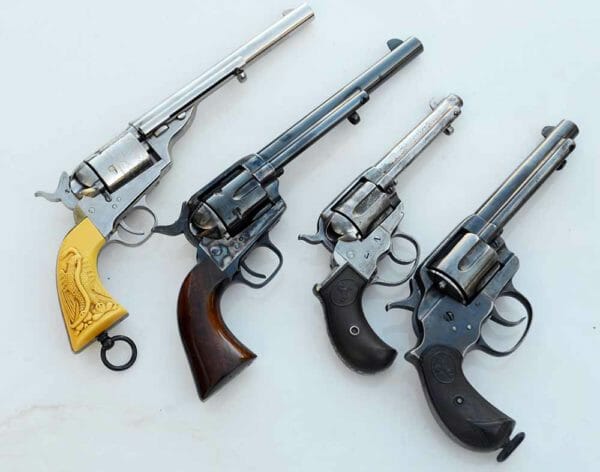
Essentially a strut was added to connect the hammer and trigger to the design of the SAA. The lockwork was more closely related to their previous M1877 design but the parts were larger, making for a more robust handgun. Some of these parts are interchangeable with the SAA.
The M1878 went by the catalog name of “Frontier Six-Shooter” when chambered in 44 WCF. Other calibers offered included the 45 Colt, 38 WCF (38-40), 32 WCF (32-20), 455 Webley and 476 Eley. Colt manufactured 51,210 Model 1878 revolvers between 1878 and 1907, including 4,600 for the US Ordnance Department in 1902.
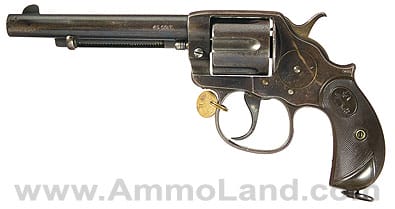
Those revolvers went off to arm the Philippine Constabulary under Brigadier General Henry T. Allen during the Philippine Insurrection. They were chambered in the Army’s 45 Colt round and had a modification which leads to confusion and misinformation that persists to this day.
Fourteen years of complaints about the heavy and still somewhat fragile trigger system prompted the Army to demand a longer trigger for more leverage and a heavier mainspring to handle the harder primers of military-issued ammunition. A new and larger trigger guard was designed to accommodate this. The appearance of this larger trigger guard has led to the incorrect assumption by collectors and historians alike that it was too allow the revolver to be fired while wearing heavy winter gloves and yields the patently false name of the “Alaskan Model” for these variants.
Sadly, many of these old revolvers have not survived to the present. Huge numbers of these old revolvers were melted down in the 1940s for the World War 2 effort, many more were given to children to play with as the ammunition became something of a rarity in the 20th century (our cynical side believes this may be the origin of the notches on the grip panel).
Fully assessing this Frontier Six-Shooter
Despite its exterior and the lock-up issues, the rest of the revolver was sound. The lanyard ring was missing, but that is an easily replaceable part. Most importantly the chambers in the cylinder were within spec for 44 WCF and the rifling in the barrel was strong with no evidence of corrosion or pitting in the bore.
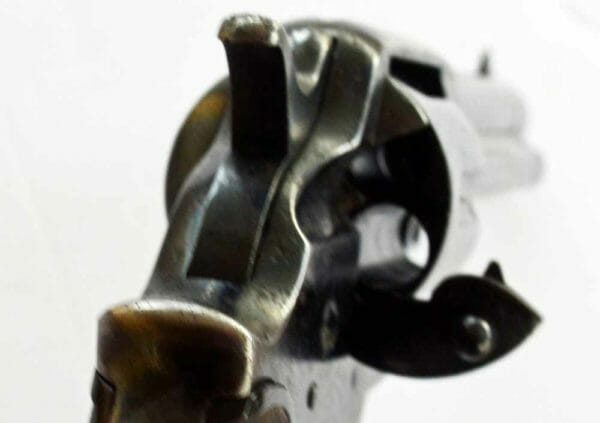
As the revolver was made in late 1898, I decided that only black-powder type loads should be used. Some so-called experts incorrectly believe that the 1898 date was established to coincide with the start of the Boer war or that it was 70 years prior to the Gun Control act of 1968 and that is why this was made the cutoff date for modern firearms. In actuality that date was chosen because it represented the advent of the invention of smokeless powder.
The 44 WCF round also went by the name “44-40” denoting a 44 caliber bullet loaded with 40 grains of black powder. Companies that made firearms chambered in this round that were not exactly on the best of terms with Winchester preferred this name to the alternative of adding a competitor’s name on their products.
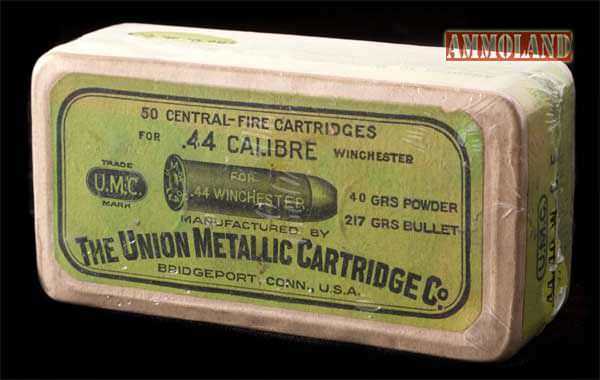
With regard to fixing the lock work and possibly retiming the revolver, there are only a handful of capable gunsmiths in the United States who can complete this type of work. We turned to one of the best in the business, Sal Lanara.
Sal works almost exclusively on the Colt M1877 and M1878 revolvers. When I described the problem he asked me to send in the revolver for assessment, but his unofficial take over the phone after describing the problem was that it could be fixed for under $200 and the cost of return shipping.
With the revolver in Sal’s capable hands, he found part of the loading gate ratchet was worn away and the hand needed to be replaced. An errant coil spring beneath the sear spring indicated that the sear spring might have issues and the grip alignment pin and mainspring tensioning screw were missing.

Sal had a spare lanyard ring on hand but found that the hand and cylinder ratchet needed replacement as well. With these parts replaced, the old Colt was able to be brought back to life.
The total cost to restore the M1878 as a safe “shooter” came out to $395 including parts, labor and return shipping. Sal has a high workload on these types of revolvers, but I received it back in a little less than 60 days.
Refinish the Colt M1878?
The Colt in question was not a family heirloom or a historical piece, but I considered refinishing it. This is where a restoration project can make or break a collector.
For a professional restoration to the condition in which it left the factory, I would be looking at a $1400-$2000 investment. The revolver had a fair degree of pitting and had been reblued at least once in its life.
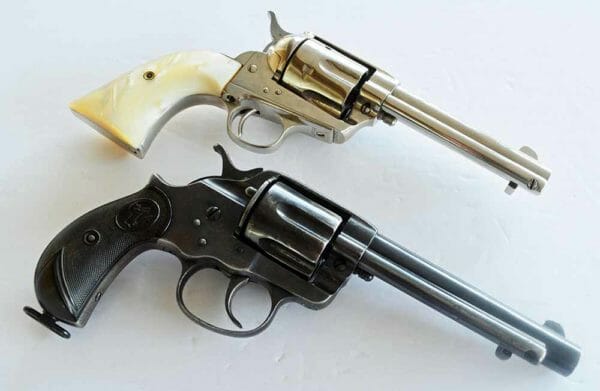
Restoration would include stripping the old finish, sanding the surface to the level of the pits, polishing and prepping all the parts and possibly having the roll marks, patent dates, serial number and factory address stamped again.
On a revolver that had no personal meaning to the author, I elected to forego this expense as I would never recover the funds spent in a complete restoration. The dry weather of Northern Nevada gives me little trepidation about potential ravages of rust. Having it complete and in working order makes it worth closer to $700 or $800. Not bad for a $79 initial investment.
On the range with the Colt Frontier Six-Shooter
Shooters need to be careful with these old firearms. Metallurgy was hit or miss during the 19th century. Many companies including Colt were not known for using the best steel and a modern smokeless powder round (even a so-called “cowboy” load) can have disastrous consequences.
We prepared some special black powder loads using Winchester brass, Pyrodex cartridge grade
As a shooter, the M1878 performs as well as it did when it left Colt about 122years ago. I test-fired the Frontier Six-Shooter with a few boxes of Black Hills Cowboy Action Ammunition. This load was mild with a 200-grain lead flat nosed bullet. I was rewarded with several six-shot groups at 50 feet with all rounds almost touching and measuring 3.25” from side to side on average because a few rounds had key-holed.
The Colt M1878 Frontier Six-Shooter fits a nice void in the author’s collection of revolvers. It was the largest double-action revolver manufactured by Colt until the introduction of the New Service nearly three decades later and snagging a piece like this for under $100 despite investing nearly 4 times that amount to bring it back to shooter grade is always something to write home about.
It cannot be used in Cowboy Action Shooting matches, despite being more historically accurate than a modern Single Action with a transfer bar and its age keeps it from working as a carry gun or shooter without the use of light black powder loads. So a lifetime in the safe next to some of its peers manufactured by Colt, Smith & Wesson and Merwin Hulbert will be its fate.
Maybe someday I will find out if those six notches mean anything beyond the markings of a 9-year-old boy thinking he was Johnny Ringo back in the 1950s.
About Mike Searson
Mike Searson’s career as a shooter began as a Marine Rifleman at age 17. He has worked in the firearms industry his entire adult life as a Gunsmith, Ballistician, Consultant, Salesman, Author, and was first certified to teach firearms safety in 1989.
Mike has written over 2000 articles for several magazines, websites, and newsletters, including Blade, RECOIL, OFF-GRID, Tactical Officer, SWAT, Tactical World, Gun Digest, Examiner.com and the US Concealed Carry Association as well as AmmoLand Shooting Sports News.
- Home page: www.mikesearson.com
- FB: www.facebook.com/mike.searson
- TWITTER: www.twitter.com/mikesearson
